Measuring turbidity is the first step toward understanding your water quality.
In this guide, we’ve shared the different ways to measure turbidity in water, as well as how to choose the best method for you, how to interpret your test results, and the steps you should take with your new knowledge.
📌 Key Takeaways:
- Turbidity is a measurement of how transparent or murky a water source is.
- There are two commonly used turbidity measurement units: nephelometric turbidity units (NTU) and formazin turbidity units (FTU).
- You can measure turbidity in drinking water with a turbidity meter, visual methods of detection, and laboratory water tests.
Table of Contents
- 🤔 What is Turbidity?
- 📏 Why Measure Turbidity In Water?
- 🔎 When Should You Measure Water Turbidity?
- 📊 How Is Turbidity Measured?
- 🧐 What Is The Average Drinking Water Turbidity Measurement?
- 📋 3 Methods for Measuring Turbidity in Water
- 🧪 How To Test For Turbidity At Home
- 📖 How To Choose The Right At-Home Turbidity Testing Method For You
- 📄 Interpreting Turbidity Results
- 📑 Final Word
🤔 What is Turbidity?
Turbidity measures water clarity, or the ability of a light beam to travel through a water source.
The more turbid the water, the more suspended particles it contains. High suspended particles concentrations will reduce the ability of a light beam to travel straight through the water source.
There are a few factors that contribute to water turbidity, including:
- Algae
- Sediment
- Organic matter
- Silt
- Clay
- Phytoplankton
- Other pollutants and materials
Sometimes, in certain environmental conditions, turbidity increases naturally without outside input.
Runoff and discharge from human activities, such as farmland, wastewater treatment plants, and construction sites, can also lead to increased turbidity in a surface water source.
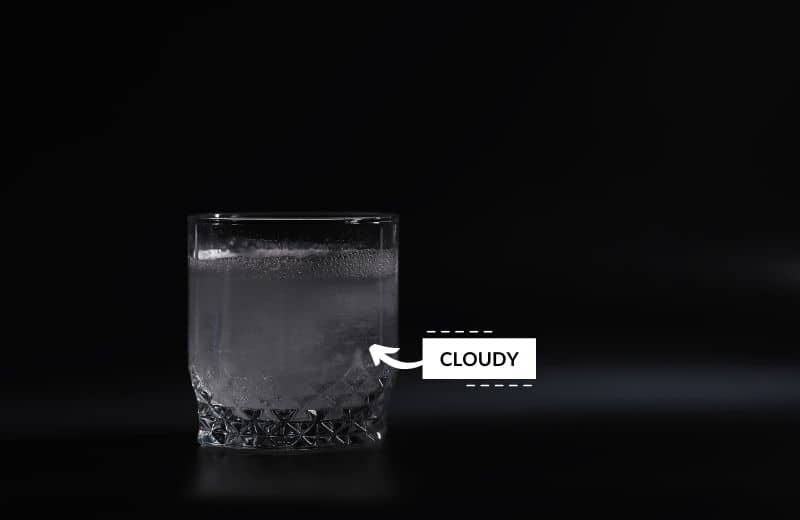
📏 Why Measure Turbidity In Water?
It’s important to measure turbidity in water because high turbidity levels have a damaging environmental impact, causing increased water temperature and affecting a fish’s ability to absorb dissolved oxygen. If your home’s drinking tap water has high turbidity, this could affect the water’s safety for human ingestion and have aesthetic effects in your home.
Certain suspended particles that contribute to turbidity, like algae, could make you sick if you drink high concentrations of them in your home’s water. By measuring turbidity, you can take further steps to identify these sources of contamination and decide on a suitable method of water treatment.
Other suspended solids, like sediment, could damage or clog your home’s plumbing system in large quantities. Measuring turbidity can help you to confirm whether your water supply is likely to be causing your plumbing problems, so you can take steps to install a water treatment system if necessary.
🔎 When Should You Measure Water Turbidity?
You should consider measuring total suspended solids and turbidity in your water supply if you’re responsible for making sure it’s safe to drink.
You don’t need to measure your water’s turbidity if you’re supplied by a city water source. This water should have a low turbidity because it will have undergone drinking water treatment before being delivered to your home. Your water utility will also conduct turbidity monitoring to ensure that your water is safe to drink.
However, if you get your water from a private well, which doesn’t undergo a treatment process before entering your plumbing supply, and your water looks visibly cloudy or murky, it’s worth conducting a turbidity test.
📊 How Is Turbidity Measured?
Turbidity is measured in nephelometric turbidity units (NTU) or formazin turbidity units (FTU).
There’s a small difference between these two units of measurement: NTU is a measurement of white light at a detection angle of 90 degrees, while FTU measures infrared light, also at a 90-degree detection angle.
NTU is the most commonly-used unit to measure turbidity, and sensors that use the NTU measurement method are compliant with the Environmental Protection Agency (EPA) method 180.1.
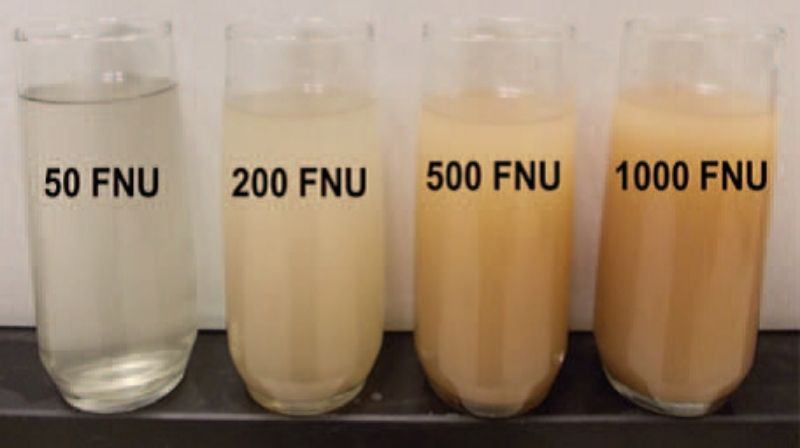
🧐 What Is The Average Drinking Water Turbidity Measurement?
The average drinking water supply should have a turbidity measurement range of 0.2-1 NTU.
High turbidity levels impact drinking water disinfection, so your water utility should aim to reduce water’s turbidity to 0.5 NTU or less, using water treatment processes such as coagulation and flocculation.
The ideal turbidity reading is 0.2 NTU or less. This applies regardless of where the water is sourced and the quality of this source.
If you’re on a municipal supply line, you can get an idea of the turbidity reading for your drinking water by reviewing your water utility’s latest Water Quality Report, which should list turbidity as one of the chemical and physical water parameters.
📋 3 Methods for Measuring Turbidity in Water
There are a few different methods for measuring turbidity in water, including with visual tools and various types of turbidity meters.
Visual Tools
Visual tools, as the name suggests, are used to give a visual analysis of a water sample’s turbidity levels. Visual tools aren’t 100% accurate because they rely on the user’s judgment, but they’re still a great way to get an indication of a water’s turbidity.
There are two visual tools you can use to measure turbidity, which are often used in lake and stream monitoring programs:
Secchi Disk
Secchi disks are black and white circular disks that are used to give a basic measurement of water clarity.
To use a secchi disk, here’s what to do:
- Lower the secchi disk into the water.
- Continue to lower the disk until you can barely see it.
- Measure the disk’s distance beneath the water. This distance tells you the water’s turbidity.
Secchi disks are an affordable, portable, and easy way to get turbidity readings in a large water body, but they’re not completely precise. The accuracy of the results depend on the quality of the lighting and the person’s eyesight.
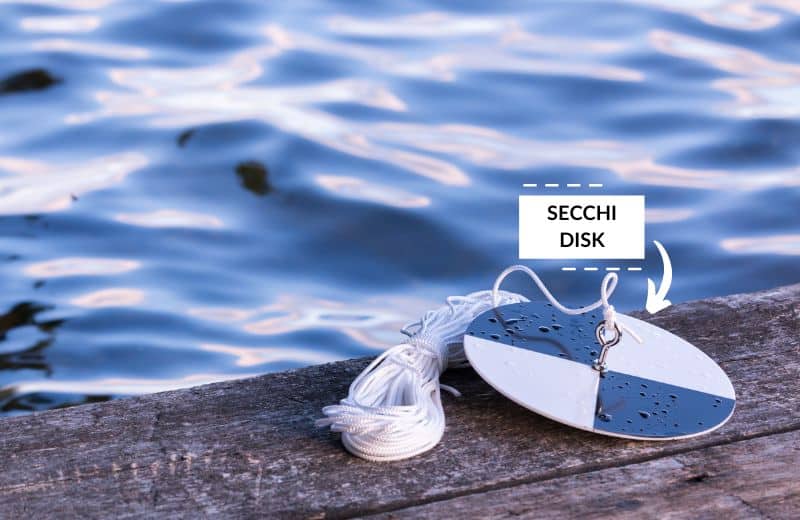
Transparency Tube
Transparency tubes are clear tubes that have a secchi disk and a release valve at their base. The tubes also have markings for measuring the amount of water collected.
To use a transparency tube to measure turbidity, follow these steps:
- Fill the tube with a water sample and mark the initial water depth.
- Look down over the top of the tube while you slowly release the valve at the base.
- Continue to release the water until you can barely make out the secchi disk, then record the remaining water depth.
- Repeat the process at least twice, then take an average reading.
Scientists who use transparency tube testing record the values in distance units, which can be converted to NTU. However, the disadvantage of this testing method is that not all tables for distance units-to-NTU conversion apply to all field conditions.
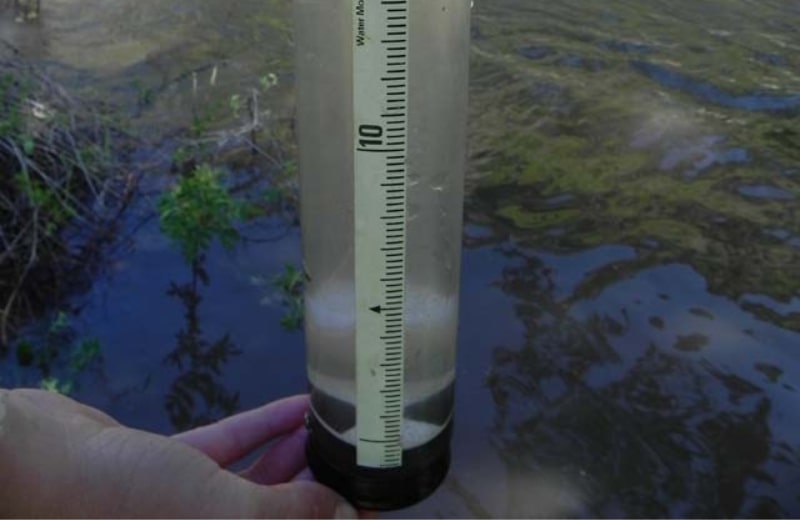
Turbidity Meters
There are a number of different turbidity meters, also called turbidity sensors and nephelometers. These devices have the same purpose: to measure the incident light scattered by total suspended solids in a water supply.
As we mentioned in the “How Is Turbidity Measured” section, two different scattered light sources can be measured by a turbidity meter: white light (compliant with EPA method 180.1) with a wavelength of 400 to 680 nanometers, and infrared light with a wavelength of 860 ± 60 nm.
Turbidity sensors have a detector that takes a reading of the light’s scatter absorbance. This detector is most commonly placed at a 90 degree angle, in accordance with both the EPA Method 180.1 and ISO7027.
There are different turbidity meters available for testing different water samples. These include:
- Benchtop meters, which are used to measure samples that can be transported to a laboratory.
- Submersible meters, which can be submerged under water to take turbidity values on-site.
- Continuous flow meters, which offer continuous monitoring of turbidity as a stream of water flows across the sensor.
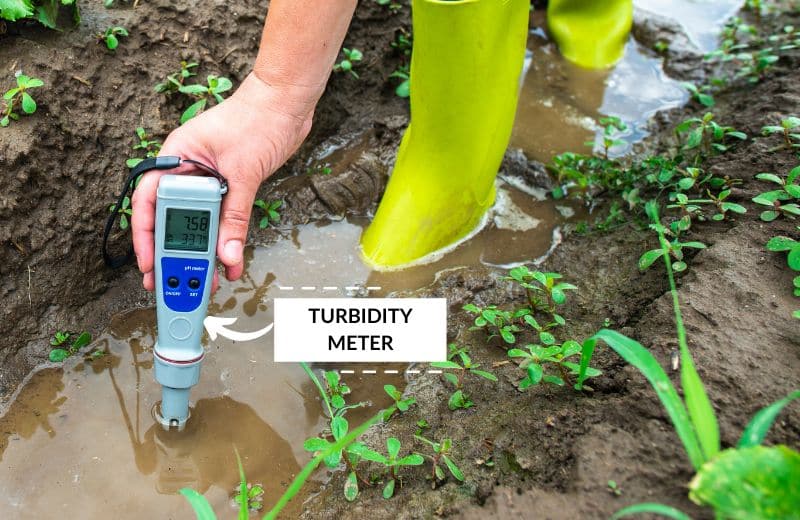
🧪 How To Test For Turbidity At Home
If you want to test your drinking water’s turbidity, you can rule out some of the scientific testing methods. You want something that’s quick, easy, and accurate, and there are three testing methods that fit this description:
- DIY test kits
- Turbidity meters
- Laboratory tests
We’ve shared more information about these three tests below.
DIY Test Kits
The quickest and most affordable at-home turbidity testing method is a DIY test kit.
You can buy a simple drinking water test kit that detects turbidity using the drop count method. This calculates the turbidity of water based on the number of drops used before a color change occurs.
Not all DIY test kits can be used to detect turbidity, so be sure to do your research to make sure your chosen test has this ability.
To use a DIY test kit for turbidity, follow these steps:
- Collect a sample of water in the test tube or vial (included in the test kit), or in a clean glass.
- Add a drop of indicator solution to your water sample.
- Add the test reagent, drop by drop, to the water sample, until the water changes color.
- The number of drops of reagent used can be compared to a table (also included in the kit) to determine the turbidity of the water sample.
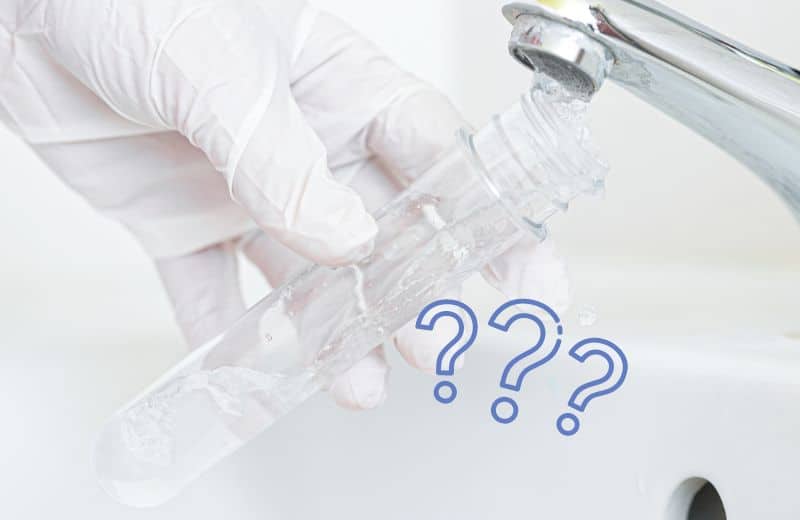
Turbidity Meters
Turbidity meters are more expensive than DIY test kits for turbidity, but more common and quicker and easier to use.
The “proper” turbidity meters used in laboratories cost $150+, but you can also buy a smaller, more basic turbidity meter (also called a turbidity sensor) that measures water’s turbidity, pH, and TDS (total dissolved solids).
To use a turbidity meter for at-home water turbidity measurements, follow these steps:
- Follow the instructions in the user manual to calibrate the turbidity meter.
- Collect a sample of tap water in a clean container.
- Wait for the data to show on the screen.
- For the most accurate results, recalibrate the meter and repeat the process several times, then take an average of the readings.
Laboratory Tests
If you want to get the most accurate turbidity measurements and you don’t mind waiting a few days to receive them, laboratory testing is the best at-home testing option.
This turbidity measurement method is, as the name suggests, conducted by a laboratory. That means you don’t have to do anything aside from taking a sample of your water and sending it to the lab.
The cost of laboratory testing for turbidity is higher – often $100-$200 or more – depending on the complexity of the testing and the number of parameters tested for alongside turbidity.
To test your water with a laboratory turbidity test, follow these steps:
- Order your lab test kit and wait for the test to arrive at your home.
- Follow the laboratory’s instructions to take one or several samples of your drinking water.
- Send the samples back to the laboratory and wait for your test results (usually within 10-14 days).
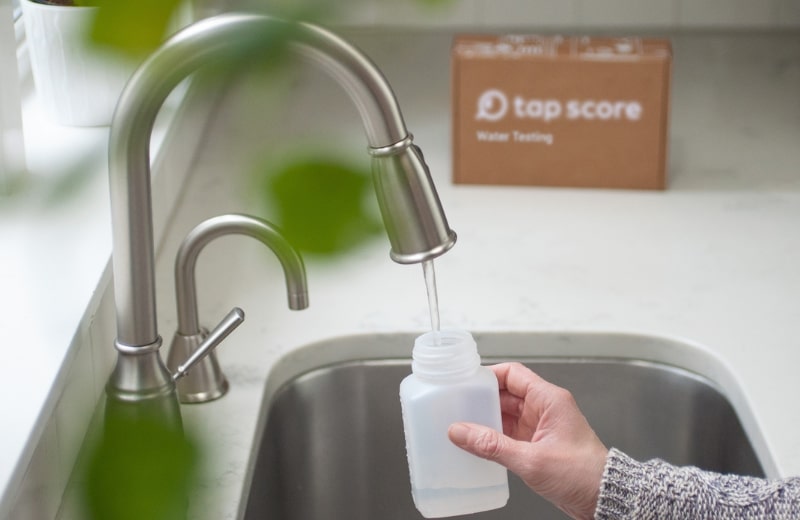
📖 How To Choose The Right At-Home Turbidity Testing Method For You
So, which type of at-home turbidity testing is right for you? It depends on a few factors, including:
- Your budget – If you have a small budget and just want an indication of your water’s turbidity, consider a DIY test kit. If budget isn’t a concern, you can choose any testing method that suits you best.
- Your water quality – If you have reason to believe that your water contains health-harmful contaminants, it’s worth paying more for a laboratory test that will give you the most accurate results.
- What else you want to test for – Lab testing is the best option if you want to test for numerous parameters and contaminants at once, while turbidity sensors will do the job if you just want to measure turbidity.
Whatever test method you decide on, make sure it has plenty of positive customer reviews and is provided by a reputable brand or laboratory.
📄 Interpreting Turbidity Results
The method you should use to interpret your turbidity results depends on the testing or detection method you use.
Most at-home tests will give you a turbidity reading in NTU. Since there isn’t an EPA Maximum Contaminant Level for turbidity, it’s best to compare your turbidity measurement with the WHO’s advised maximum turbidity concentration of 5 NTU.
Keep in mind that 5 NTU is the absolute maximum turbidity that the WHO says is safe for drinking tap water supplies. Beyond this level, water has a high likelihood of growing pathogens that cause waterborne disease outbreaks and make you sick.
So, if your test results show that your water’s turbidity is close to 5 NTU, you might want to take action to reduce turbidity and make your water cleaner and healthier to drink.
Reverse osmosis filters and ultrafiltration systems are both good methods of reducing turbidity, but if you have unusually turbid water, you might need to address the cause of the issue (e.g. if your water comes from a well, you might have a damaged well screen or a crack in the well casing that’s enabling suspended particles to enter your water supply).
Very low turbidity has a range of 0.2 NTU or less. But if you can get your water down to 0.5 NTU at least, it should be safe and clean enough to drink.
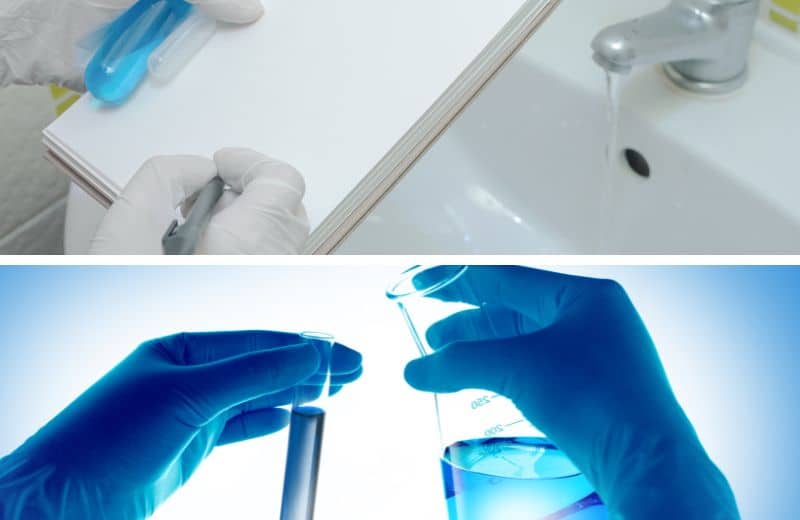
📑 Final Word
Measuring turbidity in your water is a great way to get an idea of your overall water quality.
However, if you do discover that you have turbid water, don’t stop there. A turbidity meter that measures scattered light won’t tell you exactly what suspended material your water contains. So, you don’t know for sure whether or not your water is safe.
While high turbidity suggests poor water quality and low turbidity suggests good water quality, you won’t learn which contaminants are causing the turbidity in the first place.
For that reason, if turbid water is detected, we recommend following up with additional water tests for sediment, bacteria, algae, and other organic and inorganic matter. With this information, you can pinpoint the cause of your murky water and determine the best solution based on your findings.
